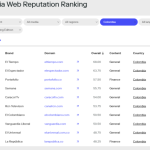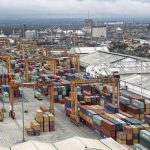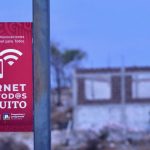After six months of conflict, the measurement of the environmental impact of the war in Ukraine is still in its infancy. Ukrainian industrial centers, attacked by Russia, have released substances dangerous to humans and nature. Biodiversity has been particularly affected by the fighting: the soil, rivers, animals and plants are already suffering. But the extent of the damage will only be known when the war is over.
A Russian infantry tank slowly burns along a Ukrainian highway. In six months of war, Russia has lost 5,420 military vehicles in Ukraine, according to the United States. Nearly as many wrecks have been dumped, sometimes in the middle of nowhere, worrying activists from the Ukrainian Nature Conservation Group (UNCG).
“The capacity of Russian tanker tanks can range between 500 and 1,600 liters,” stresses this environmental group. Although some of these tanks were empty, “a certain amount of oil escaped.” Lubricants and diesel contain lead and other heavy, sandy polycyclic metals present in all fossil fuels and other volatile organic compounds,” the NGO warned.
The contamination of Ukrainian rivers and soils remains one of the main fears of environmentalists. This concern is justified in this country, one of the most industrialized in Europe, which has a stock of 6,000 million tons of liquid waste from mining and industrial activity. Over the past six months, these places have been frequent targets of Russian attacks.
According to data from the United Nations Environment Program, the conflict has caused damage in many areas, with incidents at nuclear power plants and facilities, oil and gas infrastructure, such as refineries, drilling platforms, distribution pipelines, coal mines and agro-industrial sites. Hazardous substances were released in these explosions, such as solvents, fertilizers Y nitric acid.
“Air Poisoning”
Given the magnitude of the phenomenon, the UN has warned of a “toxic environmental legacy” for Ukraine and its region. The Ukrainian Ministry of Ecology spoke of “air poisoning” by “particularly dangerous substances”. “Pollutants can be carried by winds over great distances,” kyiv warned in a July report, after registering numerous fires caused by Russian attacks on gas stations and industrial centers, including the Vouhlehirsk thermal power plant in the Donetsk region.

Near the city of Ternopil, east of Lviv, river water samples showed ammonia levels 163 times higher than normal, and nitrate levels 50 times higherafter the remains of a Russian missile fell on a fertilizer factory.
In addition, the Ukrainian Nature Conservation Group draws attention to the pollution caused by sulfur contained in bombs “which destroy the seeds and roots of herbs with sulfuric acid that forms on contact with water.” “This conflict is extremely polluting in its intensity and extent. No region of Ukraine has been spared,” said Nickolai Denisov, director of the Swiss NGO ‘Zoi Environment Network’.
Biodiversity risk
Ukraine has many protected areas with unique species. The UNCG has drawn up a list of twenty endemic plants whose conservation is threatened by explosions, the passage of military vehicles and the devastating fires that no one puts out in combat zones.
One in three hectares destroyed by fire in Ukraine is a protected area, says the NGO, which has counted more than 37,000 fires caused by the attacks between February and June -only four months of war- based on data collected by NASA satellite images. “These plants are found in the territories occupied by Russia, where large-scale bombings take place. If we lose these species in their natural environment, we will lose them forever,” the activists lament.
More unexpectedly, the dolphins are not spared either. In the Black Sea, sonar emissions from warships destroy the inner hearing of these animals and disrupt their daily lives. Nearly 3,000 cetaceans have appeared dead on the coasts of the region since the start of the conflictaccording to a count made by Turkish, Ukrainian, Romanian and Bulgarian scientists.
KARADENİZ KIYILARINDA GÖRÜLEN OLAĞANDIŞI YUNUS ÖLÜMLERİ HAKKINDA Son bir aydır Türkiye’nin özellikle Batı Karadeniz kıyılarında tırtak türü (Delphinus delphis) yunusların ölümlerinde olağandıştedir .birlen artıştedir .birlen artıştedir .birlen artıştedir. pic.twitter.com/Myq8WLNLwe
— Türk Deniz Araştırmaları Vakfı (TÜDAV) (@TudavTudav) March 26, 2022
Ukraine is also a transit area for migratory birds, and the Black Sea coast is a nesting area. Several nature reserves, located in combat zones, play an “extremely important role in conserving populations of many bird species on a European scale,” says the Ukrainian Nature Conservation Group. However, conservation agents are no longer allowed to visit these areas. “We will discover the extent of the damage later,” lament environmental activists.
Battlefield Censuses
“We believe that while the soldiers of the Ukrainian armed forces are fighting to stop the genocide of the Ukrainian people, the environmental front must ensure the prevention of ecocide,” the NGO said. “We lack precise data, because at the moment it is impossible to survey combat zones, either because there are mines or because they are front lines or occupied territories. But it is still essential to measure the impact of the war accurately,” Oleksiy explains. Vasyliuk, director of the UNCG.
“This will take time once the war is over. In the meantime, the fighting needs to be documented as much as possible so that its consequences on the environment can be measured,” warns Nickolai Denisov, whose NGO, supported by the United Nations, has published a interactive map of the environmental risks of this war.
For its part, the Ukrainian government is making a daily inventory of the environmental damage attributed to the Russians and is studying the possibility of requesting compensation for the damage caused before international courts. Meanwhile, kyiv has already committed to carrying out an environmental restoration plan funded by the European Union and other partners, the outlines of which were presented in July. The plan includes the replanting of trees and the construction of numerous rehabilitation centers for wild animals.
However, several environmental organizations are suspicious. They accuse the Ukrainian government of taking the opportunity to increase the amount of arable land at the expense of forests and speed up the felling of trees. They have sent a letter to the European Commission asking it to ensure that the initiative, which includes billions of euros in grants and loans, is accompanied by strong environmental conditions.
*Article adapted from its original French version











Add Comment